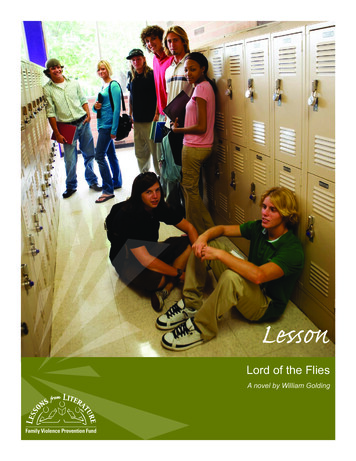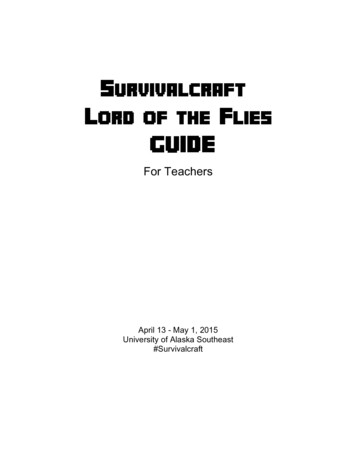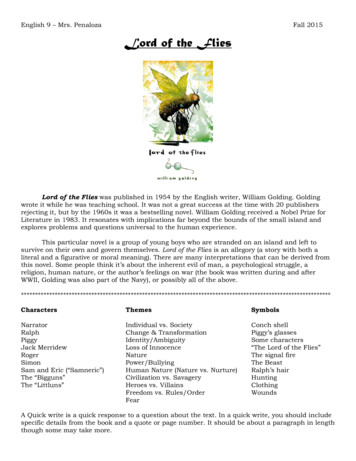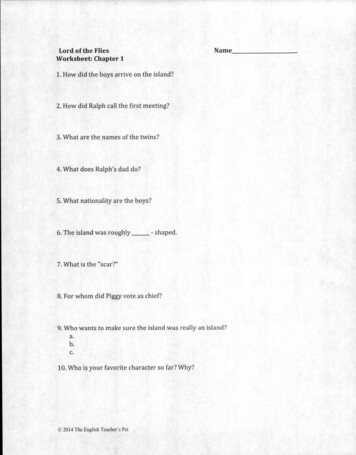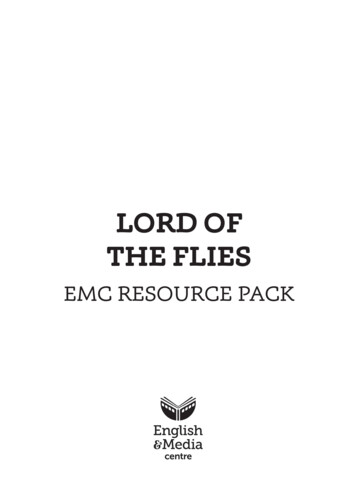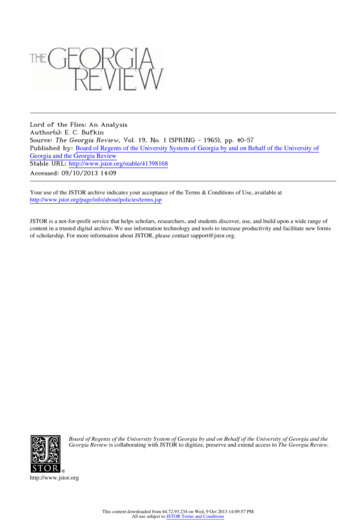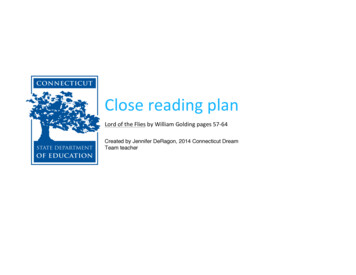
Transcription
s57- ‐64Created by Jennifer DeRagon, 2014 Connecticut DreamTeam teacher
What makes this text complex?Text and AuthorWhere to Access TextLord of the Flies by William Golding, pages 57-64Golding, William. Lord of the Flies. , 1953. Penguin Great Booksof the 20th Century.Text DescriptionThis excerpt is from the end of Chapter 4 of Lord of the Flies, in which we begin to see the emergence of the characters’ descent towards savagery and the differingleadership styles of Ralph and Jack. Beginning with the revelation they might have been rescued, Piggy and Ralph encounter Jack and his tribe returning from hunting.Ralph and Piggy confront Jack’s group about letting the fire die out because they went hunting instead. With provocation, Jack reacts violently by punching Piggy andshattering his glasses- the first physical altercation in the novel so far. The event signals a turning point in the relationship of the characters. Later that night, Jack and hisgroup proudly reenact the vicious hunt, demonstrating their increased shift to savagery. Word choice and language usage throughout reveal the thematic development.Lexile and Grade LevelLexile 770QuantitativeText Length2,314 wordsQualitativeMeaning/Central IdeasThis passage encompasses both literal and inferential levels of meaning. Beyond aplot level interpretation, students can infer theme, character development/shifts,and the impact of characters on conflict. This event marks a turning point in theboys’ shift from civilization towards savagery, demonstrated with the first pig kill,the physical assault on Piggy, and vicious re-enactment by Jack and his hunters.This is also the point where Ralph aligns himself with Piggy against Jack, afterJack shirked his fire responsibilities to serve his need for blood and power over theneeds of the whole group. At the end of this section, Ralph calls a group meeting inan attempt to regain respect and order. Further reading of this novel will enhancethe development of theme, character, and conflict.Text Structure/OrganizationThis text is chronological with a narrative structure. It has no text features orgraphics. Description and dialogue advance the plot and develop the theme. Thereare numerous complex characters (Jack, Ralph, and Piggy) interacting throughout.Dialogue jumps from one character to another without clarifiers.Prior Knowledge DemandsA general understanding of survival skills and/or living on an island would helpstudents understand the necessity of hunting and the fire. No references to othertexts or ideas are present.Language FeaturesThis text utilizes abstract and figurative language, including imagery, symbolism,and similes. There are a variety of sentences structures, with numerous complexand compound sentences utilized. Fairly complex, unfamiliar, and archaicvocabulary words are used throughout, including British terms and dialect. Forexample, academic language includes words such as “errant” and the phrase,“vaguely irritated by this irrelevance”, while expressions using dialect include,“ha’porth of meat” and “give him a fourpenny one.”VocabularyConnecticut State Department of Education2
Tier Two Words (General academic vocabulary)“Words that are far more likely to appear in written texts than in speech. [They] oftenrepresent subtle or precise ways to say relatively simple things—saunter instead of walk, forexample.” (CCSS ELA Appendix A) Errant Obscurely Ravenously Opaque Audible Assertion Ecstatic Omission Dismal Envious ResentfulTier Three Words (Domain-specific words)“[Tier Three words] are specific to a domain or field of study (lava, carburetor, legislature,circumference, aorta) and key to understanding a new concept within a text.” (CCSS ELAAppendix A) ParodyMalevolentlyPotential Reader/Task ChallengesthMost 10 graders will be able to literally interpret the main events of this text. However, students may need further instruction to attain inferential meaning, includinginferring theme and characterization. The identification and analysis of figurative language requires deeper levels of understanding. Students who are socially oremotionally immature, or extremely sensitive, may be impacted by violent and graphic descriptions.Connecticut State Department of Education3
Text-dependent questionsQuestionWhat does Piggy’s, Ralph’s, and Jack’s reaction to the fire going out reveal about each of their characters? Cite evidencefrom the text to support your response.What is the impact of the words “vicious” and “bloodied” (60) to characterize Jack?Standard alignmentPage of thisdocumentRL.9-10.15RL.9-10.410How do the interactions with Jack, Ralph and Piggy advance the plot?RL.9-10.313How does the author use conflict in the plot to create tension?RL.9-10.517How is the central idea of deterioration from civility to savagery developed through contrast?RL.9-10.222Target StandardsRL.9-10.1 Cite strong and thorough textual evidence to support analysis of what the text says explicitly as well as inferences drawn from the text.RL.9-10.2: Determine a theme or central idea of a text and analyze in detail its development over the course of the text, including how it emerges and is shapedand refined by specific details; provide an objective summary of the text.RL.9-10.3: Analyze how complex characters (e.g., those with multiple or conflicting motivations) develop over the course of a text, interact with other characters,and advance the plot or develop the theme.RL.9-10.4: Determine the meaning of words and phrases as they are used in the text, including figurative and connotative meanings; analyze the cumulativeimpact of specific word choices on meaning and tone (e.g., how the language evokes a sense of time and place; how it sets a formal or informal tone).RL.9-10.5: Analyze how an author's choices concerning how to structure a text, order events within it (e.g., parallel plots), and manipulate time (e.g., pacing,flashbacks) create such effects as mystery, tension, or surprise.Connecticut State Department of Education4
Question 1Question #1What does Piggy’s, Ralph’s, and Jack’s reaction to the fire going out reveal about each of their characters? Cite evidence from the text tosupport your response.Standard(s)covered:RL.9-10.1 Cite strong and thorough textual evidence to support analysis of what the text says explicitly as well as inferences drawn from thetext.Example response that meets standardLook-forsPiggy and Ralph are devastated and enraged by the fire going out, whereas Jack isdisappointed but believes hunting is more important than preserving the fire. Thisreveals the differing priorities of the boys; Piggy and Ralph are focused on rescue,while Jack prioritizes hunting and immediate gratification. Golding describes Ralph’sreaction: “Ralph clenched his fist and went very red.” (57). He confronted Jackimmediately, at first calmly repeating the fact that the fire went out and then savagelyshouting. Jack knew he made a mistake: “He flushed, conscious of a fault .went veryred.” (59). However, Jack justified his behavior by describing the thrill and importanceof the pig hunt as a priority. Piggy is furious at Jack and demands that he feelremorseful. Golding writes that Piggy, “forgot his timidity in the agony of his loss. Hebegan to cry out, shrilly ” (59). This prompts Jack to punch Piggy and smash hisglasses. This event shows that there are now clear dividing lines between Jack and hishunters, and the alliance of Ralph and Piggy. Additionally, the differing reaction of allthree boys reveals their priorities of civilized order and rescue versus violent chaos. Accurately identify each character’s reactionUse meaningful, thorough text evidence to describe eachcharacter’s reactionDraw inferences about characters and/or themeIf students are struggling to answer the text-dependent question, use this follow-up plan for modeling and practice:ObjectiveIn this lesson you will learn how to draw inferences about characters by citing thorough evidence from the text.Priorknowledge toreviewStudents need to know how to make inferences based on what characters say, do, think, and the author’s description of the character.Additionally, students will need to know how to identify and use textual evidence that most strongly supports inferences drawn from the text(RL.8.1).Steps toachieveobjectiveConnecticut State Department of EducationThink aloud for direct instruction5
1) Reread thesectionidentified in thequestion. 2) Ask, “Whatdoes thecharacter sayand do?” This was a long passage and I need to find the specific parts in which each character learned about the fire going out and the factthat they missed an opportunity to be rescued.I know this occurs in the first few pages of this excerpt. Let’s reread pages 57-61. Remember, to find text evidence, I can look fordialogue between the characters, or description used by Golding which shows their reactions.Okay, I’ve found Ralph’s reaction to the fire going out on page 57.Immediately, we see that Ralph realizes the fire went out. The author describes Ralph’s reaction: He’s clenching his fist, his face isred, and his voice is described as “bitter” (57).REPEAT FOR EACH CHARACTERI’ll plan to write down each characters reaction, one at a time, with text evidence for each. I want to find meaningful quotes thatreally demonstrate the strong emotions they are experiencing and what it reveals about their character. I’m going to begin withRalph.When Jack and his hunters arrive back from the hunt on page 58, Ralph simply states, “You let the fire go out.” Golding doesn’tmention that he’s screaming, shouting, or enraged. Instead Golding only offers the fact that “Ralph spoke.” Then I can recognizesome tension is building, because the bottom of page 58 says, “Ralph spoke again, hoarsely. He had not moved. ‘You let the firego out.’” Ralph has completely ignored Jack’s animated story about the hunting trip and refuses to engage in his excitement.Instead, he repeats his previous comment, which appears to have an impact on Jack, as Golding expresses, “This repetition madeJack uneasy.” Even though Ralph wasn’t yelling at first, it’s almost as though he’s more upset because he’s speaking in his calmvoice.Finally on page 59, I can tell that Ralph seems to snap in anger. Golding describes that he flung his air, pointed at the horizon, andwith a “loud and savage” voice which “struck them into silence” he exclaimed that he saw a ship which could have rescued them.The words “loud”, “savage”, and “struck” demonstrate the level of anger and rage experienced by Ralph.Ralph pushes the point with Jack, chastising him: “I was chief, and you were going to do what I said. You talk. But you can’t evenbuild huts .” I can tell that Ralph is trying to reassert his power and make Jack feel guilty for the choices he made. Ralph getsright in his face and essentially calls him out on shirking his responsibility of the fire.After the argument between Ralph and Jack, I can jump to the bottom of page 61, after Jack apologizes for letting the fire go out.Here, Ralph acts in an unusual manner. He sits right near the former fire and refuses to move, forcing Jack to rebuild the fire a fewfeet away. Golding writes that no one would ask Ralph to move, and “so Ralph asserted his chieftainship.”REPEAT FOR EACH CHARACTERConnecticut State Department of Education6
3) Ask, “Whatdo the wordsand actions ofthe characterlead me tobelieve?”Construct aresponse, usingevidence fromthe text, toanswer thequestion. Now it’s time to put our analysis of each character down on paper.It seems as though Ralph and Piggy were both extremely agitated and angry when they realized the fire went out, and I haveseveral pieces of text evidence that support that inference. From Golding’s description of Ralph, I can infer that he’s extremelyupset. He knows that this may have been their one chance for rescue, and they missed it because Jack’s prioritizes hunting. I caninfer that Ralph prioritizes order and rules, such as the routine of the fire and the responsibility of Jack’s group to tend to the fire.However, Jack reacts differently than Ralph. He is more embarrassed at first, and then he really doesn’t seem to care and insteadfocuses on the pig kill again which makes him proud and excited.When Ralph sits in the place of the fire and forces Jack to rebuild it in a less convenient location, it seems to be such a petty thing,but I think this reveals something about his character. With this act, Ralph reasserts the fact that he is chief and it’s disrespectful forJack to ignore direct orders. Perhaps he wants to make Jack work a little harder as penance for what he did, forcing him torecreate the fire in a less convenient spot. Again, I can tell that Ralph wants to show that he’s in charge and there will beconsequences for anyone who disobeys his orders.So I can start my response by first explaining the similarities and differences between characters’ reactions. A helpful sentencestarter may be: “When they found out that the fire had died away, Ralph and Piggy were both , while Jack was.”I’ll put the inferences in my own words and then support with a quote from the text. A helpful sentence starter may be: “Ralph isclearly and , shown by Golding’s description of him as .”REPEAT FOR EACH CHARACTER.Extension and practiceMove from the literal analysis of characters reactions to the impact of these reactions on character development and theme. An extension question may be: “What does this reveal about the characters or theme?” Have students consider this excerpt as a turning point in the novel and how the community isdividing into two groups.If students are having difficulty making inferences about characters reactions based on text evidence, they can utilize a graphic organizer that guides studentsto start with the text evidence and then make a logical inference about how the character is feeling/reacting based on the text. By completing this organizer,students will then have both the inferences and the text evidence for each character necessary to complete the constructed response.Connecticut State Department of Education7
What next?For additional practice, with students or for students' independent work,apply this learning objective and set of steps to literature to drawinferences about characters by citing thorough evidence from the text.(RL.9-10.1)In this lesson you will learn how to draw inferences about characters by citingthorough evidence from the text.1. Reread the section identified in the question.2. Ask, “What does the character say and do?”3. Ask, “What do the words and actions of the character lead me tobelieve?” Construct a response, using evidence from the text, toanswer the question.Connecticut State Department of EducationSee more examples of how to teach drawing inferences by citing evidencefrom the text. (RL.9-10.1)Close Reading Literature: The Celebrated Jumping Frog of CalaverasCountyClose Reading Shakespeare: “The Tempest” Act 1 Scene 28
Analyzing Character ReactionsTextual evidenceUse exact quotesPageNumberInferenceWhat can we tell about their character and priorities?RalphPiggyJackConnecticut State Department of Education9
Question 2Question #2Standard(s)covered:What is the impact of the words “vicious” and “bloodied” (60) to characterize Jack?RL.9-10.4 Determine the meaning of words and phrases as they are used in the text, including figurative and connotative meanings; analyzethe cumulative impact of specific word choices on meaning and tone (e.g., how the language evokes a sense of time and place; how it setsa formal or informal tone.Example response that meets standardGolding describes Jack as “vicious” and “bloodied” in order to show his violent nature.He had just arrived back from hunting, held a bloody knife in his hand, and then wipedthe blood across his forehead. It appears that he is reveling in the blood now, ratherthan being bothered by blood everywhere as most children would be. He is proud of hisconquest, of killing another living creature, and blatantly wipes blood across hisforehead in a demonstration of masculinity and power. Then, after he punches Piggy inthe stomach, he is described as “vicious with humiliation.” The word ‘vicious’ has thenegative connotation of violence, malice, and spite, which exemplifies how Jack isacting towards Piggy. While there’s still a piece of Jack that may feel badly for thisphysical violence against Piggy, he must assert his power and strength. Just as heconquered the pig, Jack demonstrates power over Piggy. Golding’s description of Jackon page 60 reveals his cruelty and malevolence, both towards animals and otherpeers.Look-fors Explain the literal and connotative meanings of the words“vicious” and “bloodied”.Summarize Jack’s actions on page 60.Describe how these words relate to Jack and what it revealsabout his character.If students are struggling to answer the text-dependent question, use this follow-up plan for modeling and practice:ObjectiveIn this lesson, you will learn how to determine the author’s meaning by analyzing the impact of specific word choice.Priorknowledge toreviewVocabulary: The literal and connotative meaning of words, how to analyze the impact of words on meaning and tone. (RL.8.4)Connecticut State Department of Education10
Steps toachieveobjectiveThink aloud for direct instruction 1) Go back tothe text toidentify how theauthor used thewords. 2) Ask yourself,“What do thesewords mean?” 3) Ask, “Whatdo these wordshelp meunderstandabout the text?” I need to identify where Golding used the words “vicious” and “bloodied” to examine the context of these words. I’m going to turn topage 60 and reread to find these words.I find that first Jack is described as bloodied when he held a bloody knife in his hand, transferred the knife to his other hand, and“smudged blood over his forehead.” (60). Basically, he smeared the pig’s blood from his weapon all over his forehead. At first,“bloodied” describes the knife, but by the end of the paragraph, it describes Jack himself.“Vicious” can be found in the middle of the page to describe Jack’s voice: “His voice was vicious with humiliation”. This happenedright after the critical moment in which Jack punched Piggy in the stomach. Jack stands over Piggy, calls him “Fatty” and tauntshim, with a “vicious” tone of voice. Immediately after, Ralph tries to intervene unsuccessfully, and Jack smacks Piggy’s glasses offhis face and moves for more fighting, but Piggy scrambles behind a rock to hide. This is the first time the boys have acted violentlytowards each other and actually engaged in physical fighting.Connotatively, I know that “vicious” and “bloodied” are both violent, negative words. Jack has wiped the blood from the knife allover his forehead. Now he looks savage, with blood across his head and a knife in his hand. He has transferred the blood from aweapon to himself, perhaps now also symbolizing that he is as deadly or violent as a knife. Also, being bloodied makes me thinkthat he’s no longer a civilized schoolboy; something is different about him now. So far, Golding has only used negative words todescribe Jack.Jack is also described as “vicious with humiliation”, and vicious makes me think of a cruel, spiteful, and malicious person. It’s amuch stronger word choice than simply “angry” or “harsh”. The term “vicious” has a more severe negative connotation, almost acombination of brutal, cruel, and evil all at once. “Vicious” makes me think that Jack wants to harm something. I also know that“vicious” can mean “dangerous and immoral” which impacts my characterization of Jack.Now that I see how Golding used the words to describe Jack, and I have a general understanding of these words, I can nowexamine how these words impact the meaning. Specifically, I want to think about how “vicious” and “bloodied” tell me more aboutJack and how Golding’s word choices impact my understanding of Jack.These words are both so violent; they tell me that Jack is an aggressive character who doesn’t mind blood. This seems verydifferent than most children I know who would panic at the sight of blood, so I’m thinking that Jack has undergone a transformationand he revels in the idea that he is covered in blood. He really has shifted from civilized to savage, and being covered in pig bloodis the physical manifestation of that change.Being described as vicious shows that Jack is a malicious, unforgiving person who is willing to compromise nearly anything toassert his power and strength. This word is used right after Jack punches Piggy, and then he berates him verbally. Just as Jackconquered the pig, it seems like Jack now wants to assert power over people too, and starts with Piggy. He is cruel anduncompromising, and becoming increasingly immoral. The word “vicious” gives me the feeling that Golding wants us to know thatJack is now dangerous and, as part of his transformation, perhaps no longer recognizes the differences between right and wrong.Understanding this about Jack may help me predict and understand his future actions as I delve farther in the book.Connecticut State Department of Education11
Extension and practice Students can reread portions of the text to identify word choice that conveys meaning about other characters, such as Piggy or Ralph. Students canthen answer the same type of question: What is the impact of these words or phrases to characterize ? If students do not know the denotation of the words “vicious” and “savage”, look at definitions using various dictionaries and compare definitions tobuild word knowledge. Explore the connotation of words, both with the terms “bloodied” and “vicious”, and with other words used to describe Piggy or Ralph. Use multipleresources such as dictionaries from different publishers, a visual thesaurus, a Co-build dictionary, students’ background knowledge of, andexperience with, the words, etc. to compare meanings of words. Students can create a continuum of words that show the degrees of meaning.What next?For additional practice, with students or for students' independent work,apply this learning objective and set of steps to literature and poetry toexamine the impact of word choice on meaning (RL.9-10.4).See more examples of how to teach the examination of the impact of wordchoice on meaning and tone. (RL.9-10.4).Close reading literature: “Mrs. Manstey’s View”In this lesson, you will learn how to determine the author’s meaning byanalyzing the impact of specific word choice.1. Go back to the text to identify how the author used the words.2. Ask yourself, “What do these words mean?”3. Ask, “What do these words help me understand about the text?”Connecticut State Department of EducationClose reading literature: “The Case of the Dying Detective”Close reading poetry: “O Captain! My Captain!”Close reading informational: “Up From Slavery” Chapter 112
Question 3Question #3Standard(s)covered:How do the interactions with Jack, Ralph and Piggy advance the plot?RL.9-10.3 Analyze how complex characters (e.g., those with multiple or conflicting motivations) develop over the course of a text, interactwith other characters, and advance the plot or develop the theme.Example response that meets standardRalph and Piggy ally themselves against Jack in this passage, while Jack moves to agreater position of power. When Ralph confronts Jack about the fire, Piggy interjects,blaming Jack, but “this from Piggy drove Jack to violence.” (60). He punches Piggyand smacks his glasses off his head, which is significant in the plot because it’s thefirst physical altercation between the boys. Piggy hides behind a rock while the huntersmock him. Jack decides to apologize for the fire (but not for hurting Piggy), however,Ralph demonstrates his disapproval of Jack’s actions by sitting in the middle of theformer fire, forcing Jack and his hunters to rebuild the fire a few feet away in a lessconvenient spot. In this manner, “Ralph asserted his chieftainship .Jack waspowerless and raged without knowing why.” (61-62). Golding pronounces that theywere now on opposite sides of a high barrier. The new alliance of Ralph and Piggy canbe seen when Ralph grabbed Piggy’s glasses to restart the fire; Golding describes,“Not even Ralph knew how a link between him and Jack had been snapped andfastened elsewhere.” Lastly, while all the hunters were enjoying the pig roast, Jackpurposely did not serve Piggy in an attempt to assert his power. This scene alsoreveals mob mentality, as Jack’s hunters follow his lead by ostracizing Piggy. Jack isnow commanding respect and power from many of the boys, while Ralph struggles toretain control.Look-fors Summarize the interactions between the three characters usingspecific text evidenceExplain the new alliance of Ralph and Piggy versus JackInfer the shift of power and/or respect from Ralph to JackExplain the impact of this interaction on the plotIf students are struggling to answer the text-dependent question, use this follow-up plan for modeling and practice:ObjectiveIn this lesson you will learn how to describe the ways in which complex characters advance the plot by examining his or her interactionswith other characters.Priorknowledge toreviewUsing dialogue to make inferences about characters and plot: Analyze how particular lines of dialogue or incidents in a story or dramapropel the action, reveal aspects of a character, or provoke a decision. (RL.8.3)Analyzing how characters interact: Analyze how particular elements of a story or drama interact (e.g., how setting shapes the characters orplot.) (RL.7.3)Connecticut State Department of Education13
Steps toachieveobjectiveThink aloud for direct instruction 1. Skim the textand note wherecharactersinteract withone another. 2. Ask yourself,“How do thecharactersspeak, act andreact to oneanother?” I need to find where Ralph, Piggy and Jack first interact in this section, which is on page 58. Here, Jack is returning, jubilant, fromthe pig hunt and Ralph confronts him about letting the fire go out. I’m going to reread pages 58-60 to review that first encounter.I also need to skim pages 61-63, where Jack creates a pig roast and purposefully leaves out Piggy. By the end of page 63, Ralphleaves the group so I can stop reading there. I need to skim these pages for the dialogue between the characters and Golding’sdescription of what’s happening so then I can determine how this interaction impacts the plot of the story.In the dialogue on pages 58-60, Piggy interrupts Ralph and blames Jack for letting the fire go out. In response, Jack gets verydefensive and then acts aggressively towards Piggy. Golding writes that this, “drove Jack to violence” (60) and he punched Piggyin the stomach. After calling him “Fatty” (60), he then smacked Piggy’s glasses off his head. I’m thinking that this must besignificant because it’s the first time any of the boys has hit one another. I wonder if it’s going to open the door to more violence! Allof Jack’s hunters start to laugh and mock Piggy; it seems like they’re just following Jack’s lead.So instead of fighting, Golding describes that Piggy hides behind a rock. Jack apologizes, but it’s not a genuine apology. On page61, he really only apologizes to Ralph for letting the fire go out, but doesn’t say anything about assaulting Piggy. Ralph seemsunsure of what to do in this situation, protesting that Jack played a “dirty trick” (61) with his apology. Ralph doesn’t seem like hewants a fight, but he does want to show Jack that what he did was unacceptable, so he decides to sit in the place of theextinguished fire, forcing Jack to rebuild the fire in a less convenient spot a few feet away. It makes me think of a sit-in, a nonviolent protest from Ralph against Jack!To start the fire, Ralph grabs Piggy’s glasses, and Golding describes, “Not even Ralph knew how a link between him and Jack hadbeen snapped and fastened elsewhere.” (62) This seems like an important quote because it’s showing that Ralph and Piggy arenow allied against Jack. The relationships between characters are changing in this interaction.Once the fire has started, Jack and his hunters hold a pig roast, but purposely forget to give Piggy any meat. Golding explains thatJack did this as “an assertion of power” (62), and Piggy complains in front of the group, begging Jack to give him meat. Ralphwasn’t sure what to do again, so Simon benevolently gave Piggy a chunk of meat. Jack is enraged and shouts at the group that itwas his leadership that got the group meat, which commands respect from all his hunters. Again, Ralph says nothing and insteadleaves the group to call a meeting in an attempt to regain control.Connecticut State Department of Education14
3. Ask, “Howdoes thischaracterizationaffect thestory?” Jotdown yourthinking usingevidence fromthe text. Now I really need to consider how the characters’ interactions impact the plot. I think this was a turning point in the story, bothbecause the boys are starting to divide into new alliances with dissention among the boys and it’s the first time an actual physicalfight broke out. Things seem to be going downhill! If I know this section of the story is important, I really need to pay attention to itand explain, “How does what we learned about the characters affect the story?”For one thing, Piggy and Ralph seem to be allied against Jack. Previously, Jack and Ralph had a mutual respect for each other,but after Jack attacks Piggy, I think Ralph has lost a lot of respect for him and sympathizes with Piggy. Ralph doesn’t exactlydefend Piggy, but he at least calls Jack out on what he did and refuses to mock Piggy as the rest of the group does. He alsoresents that Jack won’t apology to Piggy, which is what a civilized child would do if they hurt someone else. This shows Jack’sfurther de
Lord of the Flies by William Golding, pages 57-64 Where to Access Text Golding, William.Lord of the Flies. , 1953. Penguin Great Books of the 20th Century. Text Description This excerpt is from the end of Chapter 4 of Lord of the Flies, in which we begin to see the emergence of the characters' descent towards savagery and the differing


